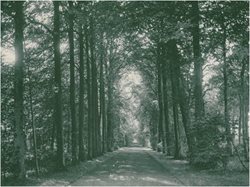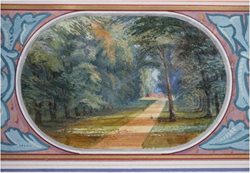Learn of the 'Wilderness' and Lime Avenue
The design of the garden is based on the geometrical construction of 4 parallel lines running northward through a ‘Wilderness’. One line is formed by a long canal in two sections and the other three by broad walks or avenues which are intersected by paths placed diagonally or at other angles. Despite its naturalistic sounding name, a ‘Wilderness’ within the context of a garden is a highly contrived space. It consists of woodland intersected by straight paths providing a network of shaded walks and controlled vistas. As a design element the Wilderness had evolved during 17th century especially in France where it was the known as a ‘bosquet’.
The main ornamental impact within the avenues and Wilderness is created by notable water features; a long narrow canal in two sections enclosed by high lime and hornbeam hedges, an oval pond placed to form a focal point towards the end of the lime avenue, and a small pond surrounded by yew trees. Outside the garden’s boundary, these avenues led the eye to such notable landmarks as St Comgalls Roman Catholic Church, All Saints Parish Church, Antrim Round Tower, and Shane’s Castle.
The Massereene family appear to have gathered an important plant collection at Antrim in the 1670s and 1680s when Sir John Skeffington, 2nd Viscount Massereene, aided by his cousin, Sir Henry Newdigate, obtained seed of various species of trees and flowers.
At this period he was also getting seed from Oxford, presumably from the Oxford Botanic Garden, then under the direction of the great plantsman, Jacob Bobart the Younger. Skeffington and Newdigate also had access to the nursery at Brompton run by influential garden designers George London and Henry Wise. In 1686 in a letter to Newdigate, Skeffington mentioned that his garden in Antrim is well stocked with evergreen trees of pines, firs and other sorts of trees.
Today there are approximately 3000 trees in the garden most of which either date from, or are descendants of (or replacement for), trees planted in the late 17th century. The main species are oak, ash, beech, horse chestnut, sweet chestnut, hornbeam, Scots Pine, yew, elm and lime. In the 18th century the available number of tree species, especially conifers, was extremely limited, but the mid-nineteenth century witnessed an arrival of great numbers of exotic species, especially from north-west America, and there are examples of some of these, including Douglas Fir, Lawson Cypress and Western Red Cedar, in the garden dating back to this time.

The Lime Avenue in the 19th century

Illustration of Lime Avenue from a book of condolence presented to Lady Massereene by the people of Antrim on the death of the 10th Viscount after a fall in the Pleasure Garden in 1863